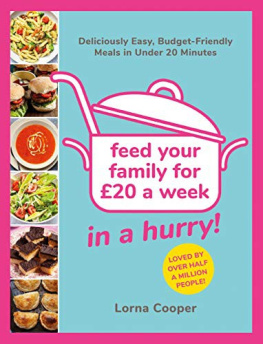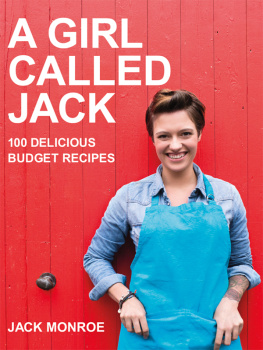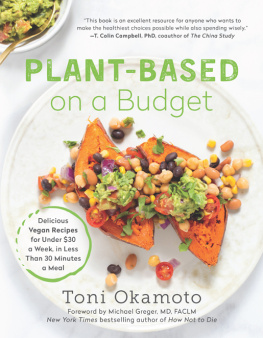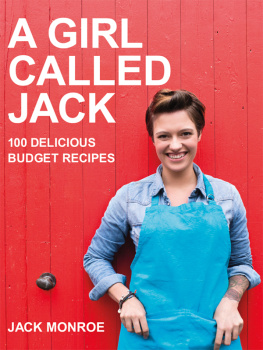This book is dedicated to my husband, Wayne, and my three gorgeous children, Allan, Thomas and Hannah, for making saving money and living the Cheapskates way easy. Without them I would never have had a reason to make the change from Spendthrift to Cheapskate, and the Cheapskates Club would never have existed. I thank you all from the bottom of my heart for being my taste-testers and for putting up with just a little taste please over and over again during the last few months. I also thank you for coming shopping with me, checking shopping lists and prices and then lugging the grocery bags into the house. Id like to thank you for sticking around to help me put it all away but, well, I guess I should be grateful for what I have. Im only joking, darlings; you dont know just how much you inspire and encourage me every single day of my life.
I love you.
$80 A WEEK CAN IT BE DONE? YES, IT CAN!
Feeding the family has become more of a challenge than ever, even for those who dont stick to a rigid budget. If you are shopping for groceries on a budget the task can seem impossible.
Dont despair; instead, take heart, because it can be done. I shop for my family of five once a month with fortnightly top-ups of dairy and fruit and vegetables for under $400 and that includes toiletries and cleaning supplies. For a family of four, the bill would be about $320 per month. Now remember, Ive been doing this since 1993, so I have lots and lots of experience. If you are just beginning to work on your grocery bill, give yourself time. Once-a-month shopping, or being as cutthroat with the prices as I am, might not be for you yet.
When it comes to grocery shopping I have a very strict routine and it very rarely varies:
- Pantry, fridge and freezer inventory
- Meal plan
- Write a shopping list:
use inventories and meal plan to work out whats needed
use a Price Book and catalogues to find best prices
write up a list in order of stores to go to
dont be afraid to try generic brands
Its a simple system and it works for me and it can work for you too, regardless of the size of your family. Whether you are a family of six, a couple or single, the process is the same: inventories, meal plan, shopping list and hit the shops. The only difference is in the quantity of the items on your shopping list and the total at the register.
Just a note: there is no hard and fast rule to calculate your grocery budget. Some people work on a percentage of income ideally no more than 10%, or a dollar amount per person $5 per person per day (a family of four would then be spending no more than $140 a week on food), or even a blanket amount of $100 a week, regardless of the size of the family.
What it all boils down to is spending however much it takes to feed your family and keep them healthy and happy and full without going into debt.
Getting Started
I discovered way back in 1993 that I was buying the same things over and over. The same grocery lines, the same toiletries and cleaning products, the same meat and basically the same fruit and vegetables. The only variations came with a change of season: in summer I bought more salad and vegetables; in winter I bought more casserole and stew types of meat. Realising my buying habits was the inspiration for the once-a-month grocery list.
The night before shopping day, I do a quick inventory of the pantry, fridge and freezer to see what basic supplies we need and add them to the shopping list. Once I know whats on hand I can do a meal plan for the month, using up what is already on hand and filling in the gaps. I only plan dinners breakfast and lunch are simple meals for us and while there is variety, the ingredients are basically the same. Having set meals for breakfast and lunch saves a lot of time too. You dont have to think very hard just remember what day it is and the rest is easy. It also means that everyone can fend for themselves. They dont need you to tell them what to eat or to get it for them. In fact, on the weekend you might get your breakfast and lunch made for you!
For breakfast we have a choice of wheat biscuits, ricies or rolled oats. At the weekend, when we have more time, pancakes or French toast are our favourites. Because breakfast is the same week to week, I know to automatically add 4 packets of wheat biscuits, 2 of ricies and 2 of rolled oats to the shopping list.
During the week, we have a set lunch menu. Years ago, we all sat down and decided what wed have for lunch and it works for us. Everyone knows what they will find in their lunchbox:
- Monday: Everyone buys lunch. Its a once-a-week treat and works well to stop us feeling deprived for the rest of the week. Fruit for snacks and drinks are brought from home.
- Tuesday: Sandwiches using the leftover meat from Sunday nights roast. If theres no leftover meat, then Tuesday is cheese and Vegemite day, with a muffin from the freezer and fruit for a treat.
- Wednesday: Focaccia pizza. I spread focaccia (or bread rolls or English muffins) with tomato sauce, sprinkle it with herbs and top it with grated cheese, then grill it until the cheese is bubbly and melted and wrap in foil to stay warm. Fruit from the bowl for snacks to fill them up.
- Thursday: Sandwiches. Egg and lettuce most of the time.
- Friday: Sausage rolls or pasties, depending on whats in the freezer. Also a muffin or slice of cake and fruit.
- Saturday: Soup and toast in winter, salad rolls in summer.
- Sunday: Baked beans on toast or toasted sandwiches (cheese and tomato, spaghetti, meat and cheese, etc).
With breakfast and lunch covered, its time to work out whats for dinner. A quick and simple trick that can really speed meal planning up is to assign a type of meal to each day of the week.
- Sunday: Roast
- Monday: Pasta
- Tuesday: Fish
- Wednesday: Mince
- Thursday: Takeaway (either bought or from Mums Kitchen)
- Friday: Leftovers
- Saturday: Soup and sandwiches
If you do this and nothing else you at least know what to take out of the freezer in the morning. You can spend the day thinking of ways to prepare it if you need to.
The next step is to actually assign recipes to the meal, e.g. roast stuffed chicken, lamb with rosemary and garlic, pasta with Bolognaise sauce, etc. Doing this helps with your shopping list youll know exactly what ingredients you need to cook these meals. Check your inventories to make sure you have what you need and add anything that has to be bought to your shopping list.
When youve mastered these two steps, you can get adventurous and assign new recipes to the meals. Start with one new recipe per week and aim for a day when you know youll have time to spend in the kitchen a Sunday night dinner could become a regular new weeknight recipe.
To learn more about meal planning, see Chapter 2.
The Shopping List
When it comes to buying groceries on a budget, I find a Perpetual Shopping List (see Chapter 6) essential. I keep a blank shopping list on the kitchen notice board and, in theory, when something needs to be replenished it is written on the board. Remember, I live with three teenagers so it doesnt always work out that way, hence me doing the inventories. I always shop with a list as I like to get it all in one hit, and if I miss something, it has to wait until the next shop.
Once the meal plan has been worked out I can add to the shopping list. I write down everything I need, making sure I include the quantities. Unless it is something really important Im not brand precious. Remember, flour is flour, sugar is sugar and there is bound to be one brand on sale most of the time.


















